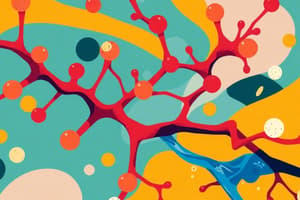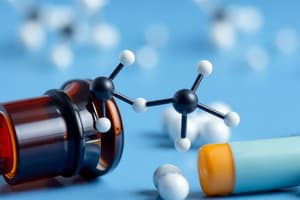Podcast
Questions and Answers
In a scenario where a novel synthetic muscarinic receptor subtype with constitutive activity in vascular smooth muscle is discovered, which of the following intracellular signaling alterations would paradoxically lead to vasoconstriction, assuming no compensatory mechanisms?
In a scenario where a novel synthetic muscarinic receptor subtype with constitutive activity in vascular smooth muscle is discovered, which of the following intracellular signaling alterations would paradoxically lead to vasoconstriction, assuming no compensatory mechanisms?
- Increased adenylyl cyclase activity, leading to elevated cAMP levels and subsequent activation of protein kinase A (PKA). (correct)
- Stimulation of phospholipase C (PLC), resulting in increased inositol trisphosphate (IP3) and diacylglycerol (DAG) production, ultimately activating protein kinase C (PKC).
- Activation of RhoA/Rho kinase pathway, leading to myosin light chain (MLC) phosphorylation and smooth muscle contraction.
- Enhanced nitric oxide synthase (NOS) activity, producing nitric oxide (NO) that activates guanylate cyclase, increasing cGMP levels, and activating protein kinase G (PKG).
A researcher is investigating the effects of a novel compound on the autonomic nervous system. The compound is found to selectively inhibit the $G_i/G_o$ protein-coupled signaling cascade downstream of M2 muscarinic receptors in the sinoatrial (SA) node. Which of the following effects on cardiac function would most likely be observed?
A researcher is investigating the effects of a novel compound on the autonomic nervous system. The compound is found to selectively inhibit the $G_i/G_o$ protein-coupled signaling cascade downstream of M2 muscarinic receptors in the sinoatrial (SA) node. Which of the following effects on cardiac function would most likely be observed?
- An increase in heart rate resulting from the uninhibited activity of adenylyl cyclase and elevated cAMP levels. (correct)
- A decrease in heart rate due to enhanced potassium efflux and hyperpolarization of SA nodal cells.
- An increase in atrioventricular (AV) nodal conduction velocity caused by enhanced gap junction communication.
- A reduction in atrial contractility mediated by decreased calcium influx through L-type calcium channels.
A patient with glaucoma is prescribed pilocarpine eye drops. Considering the mechanism of action, which intracellular change in the ciliary muscle cells is most directly responsible for the drug's therapeutic effect of reducing intraocular pressure (IOP)?
A patient with glaucoma is prescribed pilocarpine eye drops. Considering the mechanism of action, which intracellular change in the ciliary muscle cells is most directly responsible for the drug's therapeutic effect of reducing intraocular pressure (IOP)?
- Activation of phospholipase C (PLC), resulting in increased inositol trisphosphate ($IP_3$) and subsequent calcium release from the sarcoplasmic reticulum. (correct)
- Increased activity of myosin light chain phosphatase (MLCP) leading to smooth muscle relaxation.
- Inhibition of Rho kinase, leading to decreased phosphorylation of myosin light chain (MLC) and smooth muscle relaxation.
- Decreased intracellular calcium concentration due to inhibition of inositol trisphosphate ($IP_3$) receptors.
During a research trial, it is discovered that a novel irreversible cholinesterase inhibitor demonstrates significantly prolonged duration of action in vivo compared to edrophonium, despite having similar in vitro inhibitory potency. Which of the following mechanisms best explains this discrepancy?
During a research trial, it is discovered that a novel irreversible cholinesterase inhibitor demonstrates significantly prolonged duration of action in vivo compared to edrophonium, despite having similar in vitro inhibitory potency. Which of the following mechanisms best explains this discrepancy?
In the context of autonomic ganglia modulation, which of the following scenarios would result in a paradoxical decrease in sympathetic tone in a patient chronically treated with a high dose of a non-selective muscarinic agonist?
In the context of autonomic ganglia modulation, which of the following scenarios would result in a paradoxical decrease in sympathetic tone in a patient chronically treated with a high dose of a non-selective muscarinic agonist?
A researcher is developing a novel therapeutic agent designed to selectively enhance salivary gland secretion in patients with severe xerostomia secondary to Sjogren's syndrome, but wishes to avoid cardiovascular side effects. Which of the following strategies would be most effective in achieving this selective muscarinic agonism?
A researcher is developing a novel therapeutic agent designed to selectively enhance salivary gland secretion in patients with severe xerostomia secondary to Sjogren's syndrome, but wishes to avoid cardiovascular side effects. Which of the following strategies would be most effective in achieving this selective muscarinic agonism?
A patient presents with acute angle-closure glaucoma. Given the understanding of cholinergic pharmacology, what intervention strategy, focusing on muscarinic receptor activity, would be most appropriate to rapidly reduce intraocular pressure (IOP) and facilitate angle opening?
A patient presents with acute angle-closure glaucoma. Given the understanding of cholinergic pharmacology, what intervention strategy, focusing on muscarinic receptor activity, would be most appropriate to rapidly reduce intraocular pressure (IOP) and facilitate angle opening?
A researcher discovers a novel muscarinic agonist that, paradoxically, causes bronchodilation when administered in vivo. Subsequent in vitro studies reveal that this compound has negligible direct effects on airway smooth muscle muscarinic receptors. Which of the following mechanisms best explains this bronchodilatory effect?
A researcher discovers a novel muscarinic agonist that, paradoxically, causes bronchodilation when administered in vivo. Subsequent in vitro studies reveal that this compound has negligible direct effects on airway smooth muscle muscarinic receptors. Which of the following mechanisms best explains this bronchodilatory effect?
A patient with a history of benign prostatic hyperplasia (BPH) and urinary retention is being considered for treatment with bethanechol. Which of the following pre-treatment assessments is most critical to perform to avoid potentially life-threatening complications?
A patient with a history of benign prostatic hyperplasia (BPH) and urinary retention is being considered for treatment with bethanechol. Which of the following pre-treatment assessments is most critical to perform to avoid potentially life-threatening complications?
A researcher is investigating the structural requirements for cholinesterase inhibitor binding and activity. They synthesize a series of novel carbamate derivatives and assess their ability to inhibit acetylcholinesterase (AChE) and butyrylcholinesterase (BuChE). Which of the following findings would provide the strongest evidence for a selective AChE inhibitor design?
A researcher is investigating the structural requirements for cholinesterase inhibitor binding and activity. They synthesize a series of novel carbamate derivatives and assess their ability to inhibit acetylcholinesterase (AChE) and butyrylcholinesterase (BuChE). Which of the following findings would provide the strongest evidence for a selective AChE inhibitor design?
Flashcards
Autonomic Nervous System
Autonomic Nervous System
Controls involuntary body activities, such as heart rate, digestion, and respiration.
Parasympathetic Nervous System
Parasympathetic Nervous System
A system promoting 'rest and digest' functions like digestion, salivation and urination.
Cholinergic Receptors
Cholinergic Receptors
A type of receptor activated by acetylcholine, divided into muscarinic and nicotinic types.
Acetylcholine (ACh)
Acetylcholine (ACh)
Signup and view all the flashcards
Muscarinic Receptor (M1)
Muscarinic Receptor (M1)
Signup and view all the flashcards
Muscarinic Receptor (M2)
Muscarinic Receptor (M2)
Signup and view all the flashcards
Muscarinic Receptor (M3)
Muscarinic Receptor (M3)
Signup and view all the flashcards
Nicotinic Receptors
Nicotinic Receptors
Signup and view all the flashcards
Parasympathomimetics
Parasympathomimetics
Signup and view all the flashcards
Muscarinic Agonist Effects
Muscarinic Agonist Effects
Signup and view all the flashcards
Study Notes
- Clinical pharmacology lecture about cholinergic drugs.
- The lecture is given by Dr. Asmaa El-rakhawy
Learning Outcomes
- Cholinergic receptors exist
- Parasympathomimetics can be classified
- The mechanism of action of parasympathomimetics is important
- Different cholinergic agonists exist and have different uses
- Parasympathomimetics have side effects and contraindications that must be considered
Autonomic Nervous System
- The Autonomic Nervous System controls involuntary body activities
- The sympathetic nervous system responds to stress
- The Parasympathetic nervous system favors peace, rest and digesting
Parasympathetic Nervous System
- The parasympathetic nervous system handles a variety of functions
- These include miosis, salivation, bronchoconstriction, bradycardia, digestion, and urination
- Acetylcholine is used in both the preganglionic and postganglionic neurons
Functional Systems
- The parasympathetic (cholinergic) system uses acetylcholine (ACh) as a neurotransmitter
- Cholinesterase enzyme (AChE) metabolizes Acetylcholine
- Muscarinic (M) and Nicotinic (N) receptors (cholinoceptors) are present
Muscarinic Receptors
-
M1 muscarinic receptors are in the CNS
-
M1 receptors effect motor activity, attention and memory
-
M1 receptors in the stomach promote HCL acid secretion
-
M1 receptors are Gq protein coupled, increasing IP3 & DAG, which leads to increased Ca2+
-
M2 receptors are in the heart
-
Gi leads to decreased cAMP
-
Results in a decreased heart rate
-
Atrial ventricular node decreases
-
Sinoatrial node decreases
-
M3 receptors facilitate miosis. and causes constriction of the ciliary muscles
-
M3 receptors constrict bronchioles in the lungs while increasing secretions.
-
M3 receptors dilate blood vessels and increase gland secretion.
-
M3 receptors also control wall contractions, sphincter relaxation, and urination.
-
M3 receptors are Gq protein coupled, increasing IP3 & DAG, which leads to increased Ca2+
Nicotinic Receptors
- Nicotinic receptors are ion channel receptors, allowing an increase in Na+ that leads to depolarization
- Nn receptors are found in the adrenal medulla and autonomic ganglia
- Nm receptors are found in somatic nerves and skeletal muscles, related to skeletal muscle contractions
Para-sympathomimitics Classification
- Direct and indirect classifications exist
- Direct drugs can either be choline esters or alkaloids
- Indirect drugs are ChE inhibitors, that can be reversible or irreversible
- Choline esters include Acetylcholine, Bethanechol, Carbachol and Methacholine
- Alkaloids include Pilocarpine and Cevimeline
- Reversible ChE inhibitors include Physostigmine, Neostigmine, Pyridostigmine, and Donepezil.
- Irreversible ChE inhibitors include Organo-phosphate compounds
Acetylcholine Info
- The mechanism is direct stimulation of M & N receptors
- Oral administration is ineffective because of poor absorption
- It must be given via injection
- Hydrolyzed rapidly by cholinesterase enzyme, leading to a very short duration of action
Muscarinic Effects
- Cardiovascular system effects include decreased heart rate (M2), vasodilation in blood vessels (M3), and decreased blood pressure
- Respiratory effects (M3) include bronchoconstriction (BC) and increased bronchial secretion
- Eye effects (M3) include miosis (stimulation of the constrictor pupillae) and accommodation for near objects (stimulation of ciliary muscles).
- Gastrointestinal tract effects (M3) include increased motility and relaxation of sphincters.
- Urinary tract effects (M3) are that stimulation of the detrusor muscle (↑ motility ) & relaxes the internal urethral sphincter resulting in bladder evacuation
- Exocrine glands effects (M3) causes stimulated salivary, gastric, bronchial, lachrymal and sweat gland secretions.
Nicotinic Effects
- Increases all types of autonomic ganglia (Nn)
- Increases stimulation of the motor end plate (neuromuscular junction) which leads to skeletal muscle contractions (Nm).
Carbachol
- Is a choline ester, resistant to hydrolysis by AChE, effective orally, and has a long duration
- Stimulates both Muscarinic & Nicotinic receptors
- Used to treat open-angle glaucoma
- Administered via local eye drops to cause miosis, which increases the aqueous humor drainage which lowers IOP
Bethanechol
- Is a choline ester
- Stimulates only muscarinic receptors
- Used for post-operative urine retention and paralytic ileus (in the absence of organic obstruction)
Pilocarpine
- Natural plant alkaloid
- Has Muscarinic effects
- Has No nicotinic effects
- Local eye drops of pilocarpine decrease IOP in chronic open-angle glaucoma.
Cevimeline
- Is a Synthetic alkaloid
- Has Muscarinic effects
- Has No nicotinic effects
- Cevimeline is given orally
- Increases salivary secretion & treats xerostomia (dry mouth).
Adverse Effects
- Hypotension
- Diarrhea
- Nausea
- Vomiting
- Bradycardia
- Bronchoconstriction
- Sweating
- Salivation
Contraindications of muscarinic agonists
- Bronchial asthma
- Heart block
- Peptic ulcer
Review Questions
- The activation of muscarinic receptors in bronchiolar smooth muscle is associated with: Increase in IP 3 and DAG
- One systemic effect of a muscarinic agonist is a reduced heart rate (bradycardia).
Studying That Suits You
Use AI to generate personalized quizzes and flashcards to suit your learning preferences.




